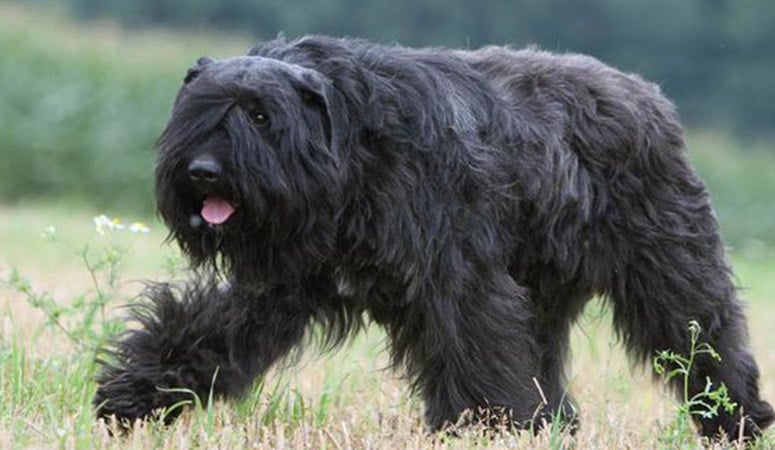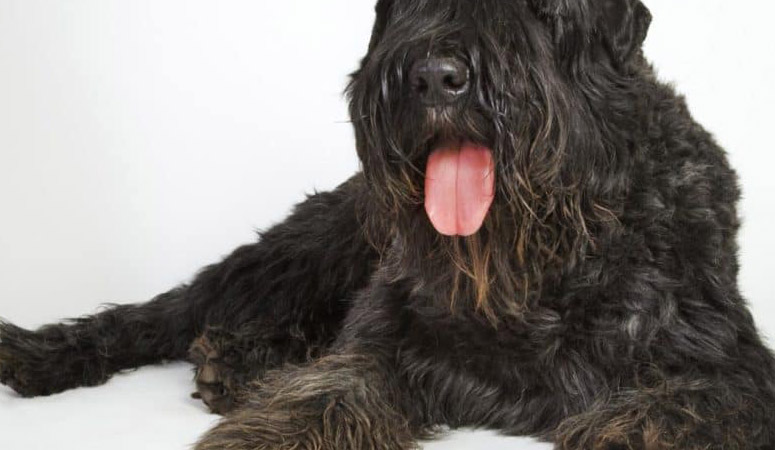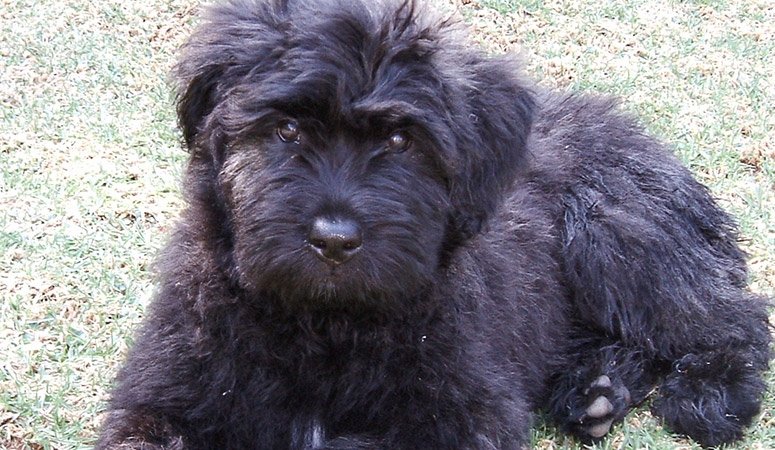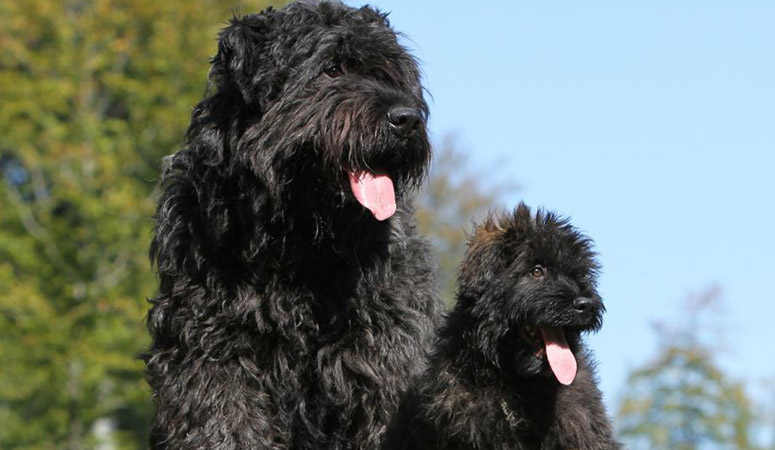Bouvier des Flandres

As a farm dog, the Bouvier des Flandres has great power to pull loads, and they are alert enough to keep watch and agile enough to herd cattle. The breed are serene and gentle companions at home when given plenty of opportunity for play, work, and exercise to head off boredom. With sterling character, huge heart and keen intelligence, they are popular among the lovers over the world.
| Other Names | Belgian Cattle Dog, FlanDers Cattle Dog, Franco-Belgian Cattledog, Franco-Belgian Dog, Vlaamse Koehond |
| Color | Black, Brindle, Fawn, Gray Brindle, Pepper & Salt |
| Height | Males: 24-28 inches. Females: 23-27 inches. |
| Weight | Males: 77-100 pounds. Females: 59-85 pounds. |
| Life Span | 10-12 years |
| Personality | Affectionate, Courageous, Strong-Willed |
| Exercise | Needs Lots of Activities |
| Origin |
| Popularity | #92 |
| Groom Needs | Daily Brushing |
| Kids Friendly | No |
| Dog Friendly | Yes with supervision |
| Watch Dog | Yes |
| Family Dog | |
| Litter Size | 5–10 pups |
Bouvier des Flandres Pictures
Bouvier des Flandres Video
Introduction
The Bouvier des Flandres is a working dog breed, that appears in lavish beards and mustache. From a Cowdog life in Belgian and French plains and farmlands, the Bouvier has transformed into an important member of the family, as an excellent watchdog, companion, and joy bringer. They come in a double coat, the top of which appears ruffled, as though in dire need of grooming. Brindle, fawn, grey, black, or blonde are the common coat colors in which they can be seen.
The males are more or less comparable to the females in size, only that they appear more muscular and quite sturdier than the females. A standard male weighs approximately 70- 110 pounds at the scales, while a female tags below that of the male by a few points. In height, a full-grown male stands 24-28 inches from shoulder to paw, and a similar female measures 23-27 inches. The Bouvier des Flandres are willed, lovable, and courageous dogs. They have an average life expectancy of 9-12 years.
Living with Bouvier des Flandres
The Bouvier requires quite a bit of grooming to keep his coat looking good, but he doesn’t need shedding excessively. And it’s important to start this process from his puppyhood so that so he learns to accept grooming as a normal part of his life.
Bathe him every six to eight weeks and trim his coat every few months.
With a fluffy, thick coat, the Bouvier needs to be brushed several times a week, and it’s a great idea to check the coat for burrs, ticks, or weeds every day.
Trim his nails once or twice a month if your dog doesn’t wear them down naturally to prevent painful tears and other problems. With blood vessels in dog toenails, you can’t cut too far, or you can cause bleeding — and your dog may not cooperate the next time he sees the nail clippers come out. If you’re not experienced, ask a vet or groomer for pointers.
Brush your Bouvier’s teeth at least two or three times a week to remove tartar buildup and the bacteria that lurk inside it. Daily brushing will help more to prevent gum disease and bad breath.
His ears should be checked weekly for redness or a bad odor, which can indicate an infection. Don’t insert anything into the ear canal; just clean the outer ear when you check your dog’s ears, and wipe them out with a cotton ball dampened with gentle, pH-balanced ear cleaner to help prevent infections.
The Bouvier isn’t highly active, but he does need regular exercise. A healthy Bouvier requires several hours of physical activity each day so they stay healthy and don’t become restless. Dog sports are a great way to keep them active, as are boisterous play sessions and long walks.
They are an excellent fit for an active household with an owner who hikes or jogs or even bikes, and they should be on a leash or need a large, enclosed exercise area where he can romp and play, preferably with other dogs or kids who will keep him in good condition both mentally and physically.
They are happiest when they stay busy, but if left alone for too long, they will feel bored and easy to get destructive and have unwanted behaviors like barking, chewing, and chasing. Heavy exercise should be limited while he is a growing puppy.
Bouviers are fairly comfortable outside in cold weather, but they become uncomfortable when it’s very hot and humid.
The sheer size, and energy level of the Bouvier required him to be fed a large amount of high-quality dry kibble twice a day instead of one large meal. Generally, this breed requires about 3 to 5 cups of good quality dry dog food each day, but this will vary based upon your Bouvier’s activity level, metabolism and age.
You’ll need to take special care if you’re raising a Bouvier puppy. The Bouvier grows very rapidly between the age of four and seven months, making him susceptible to bone disorders. So feed your puppy a high-quality, low-calorie diet to keep him from growing too fast.
Watch your dog’s calorie consumption and weight level to keep your Bouvier from obesity and in good shape by measuring his food and feed him twice a day rather than leaving food out all the time.
Clean, fresh water should be available at all times.
Learn about which human foods are safe for dogs, and which are not. Check with your vet if you have any concerns about your dog’s weight or diet.
Bouviers are generally healthy, but like all breeds, they’re prone to certain health conditions, such as elbow and hip dysplasia, hypothyroidism, eye conditions (including cataracts, glaucoma, entropion, and ectropion), gastric torsion and sub-aortic stenosis. Not all Bouviers will get any or all of these diseases, but it’s important to be aware of them if you’re considering this breed.
Like all large and deep-chested breeds, the Bouvier can experience gastric dilatation and bloat. Owners should learn how to identify this potentially life-threatening condition and learn what emergency steps to take to address it.
Responsible breeders will screen their stock for health conditions regularly by some common health tests, such as hip evaluation, elbow evaluation, ophthalmologist evaluation and cardiac exam.
Total Annual Cost: $3562.9
Cost is estimated for the first year and may vary depending on many factors, such as dog food, health care, leash, collar, licensing, possible fencing, crates, training and obedience classes, dog-walking, grooming, treats, toys, flea, tick, and heart-worm meds, microchips, etc.
The Bouvier is generally eager to please, which makes training fairly easy, and the training should start from his puppyhood. Sometimes stubborn, you must be consistent and firm to overcome his dominant personality.
Early socialization is important and puppy training classes are highly recommended, which can help puppies or adult dogs learn how to be friendly and get along with other dogs and people. You can take the Bouvier puppy to many places that allow dogs, like pet supply and building supply stores to familiarize the dog to strangers and unfamiliar situations.
Extremely eager to please, once they know what you want them to do, they will do their best to satisfy you. The Bouvier is happiest when he has a job to do, whether that job is babysitting, herding, obedience, or guard dog or rescue work. This breed is well suited for search and rescue work and adapts to the training easily.
Crate training is an important aid in housetraining, which can keep the Bouvier safe and out of trouble when you are away from home. But it shouldn’t over a few hours at a time in it except when he’s sleeping at night because Bouviers aren’t meant to spend their lives locked up in a crate or kennel.
With a strong herding drive, he may be unable to resist the temptation to chase people on bikes, cars, or other animals, which can endanger him and others. So leash training is a must with the Bouvier, although the breed is not known for wandering off.
History
The Bouvier des Flandres originated in Southwest Flanders, a region which had cut across three different countries — Belgium, France, and the Netherlands. Till date, the Belgians and French both claim the nativity of this breed of dogs. Old names by which this breed go by include, vuilbaard, toucher de boeuf or pic, and koehond, all pointing towards the fact that this breed had originally functioned as a cowherd in the Flanders. In the Medieval times, French and Belgian breeders preferred to breed versatile and utilitarian dogs, for the benefit of performing multiple tasks from herding of stock to guarding of the farm holds, rather than specialized dogs, like was common in parts of the United Kingdom.
By the turn of the 20th century, this breed had begun to climb the popularity ladder highly admired as a versatile breed. This got breed enthusiasts and fanciers together to seek out ways to improve the breed. Soon, a breed club was first founded in Belgium, before a crew of delegates from France and Belgium drafted out the first standard for the breed in 1936. Prior to this were conflicts over the breeding of the different varieties of the breed ( Paret, Moerman or Roeselare, and Briard) that existed before the 1900s.
After World War I, the Bouvier breed had almost gone extinct, since their farmers and breeders had fled their homes and dogs for dear life. Several of these dogs were killed and destroyed in the course of the war. It took many more years of slow growth, even after World War II, for the Bouvier des Flandres to regain recognition. An American breed club for the Bouvier was formed in 1963.
Helpful Information
Breed Club: THE AMERICAN BOUVIER DES FLANDRES CLUB
Breed Club Link: http://www.bouvier.org/
Breed Club Rescue: American Bouvier Rescue League
Breed Club Rescue Link: http://www.abrl.org/



